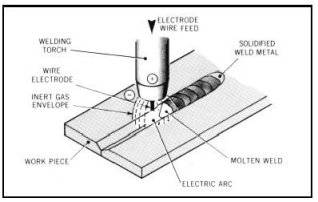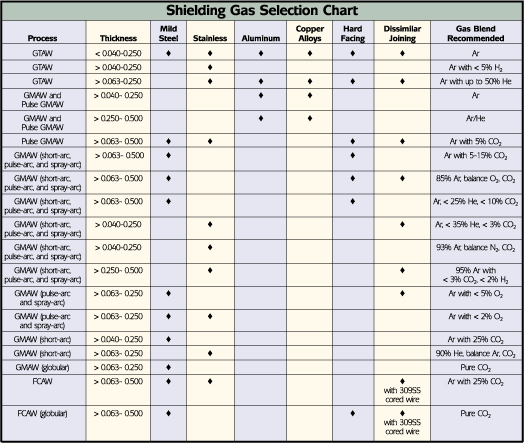Welding Gases and Thermal Process Gases Information
Welding gases and thermal process gases are especially formulated for welding, cutting or other high-temperature processing applications; either because they produce a large amount of heat or provide a protective environment. Welding and thermal processing gases include acetylene, propylene, liquefied petroleum gas, natural gas, hydrogen, and methylacetylene-propadiene (MAPP) gas. Welding gases and thermal process gases are often used in conjunction with an oxygen gas supply to produce a very hot flame.

Image credits: Matheson; Praxair
Welding gases and thermal process gases also include shielding gases that are used to protect the weld area from atmospheric gases such as oxygen, nitrogen, carbon dioxide, and water vapor. A shielding gas is often a semi-inert or inert gas. Argon is the most cost-effective shielding gas and other gases include helium and carbon dioxide. Binary, ternary, and even some quaternary mixtures with oxygen are also used and are specified based upon the type of welding, alloy composition, and material parameters such as thickness. Shielding gases are used in indoor gas arc welding applications to limit the possible dispersion of the welding gas by atmospheric conditions.
Shielding gases are used in arc welding where a power supply creates an electric arc between an electrode and the metal stock to be welded. In gas metal arc welding (GMAW), also known as MIG welding, shielding gases are used to stabilize the arc on the metal that is being welded and shield the arc and the molten metal from atmospheric gases. MIG welding was originally developed to weld non-ferrous metals such as aluminum, but is now commonly used to weld steel. Gas tungsten arc welding (GTAW, also known as TIG welding) also requires a shielding gas such as an argon/helium mixture or an argon/hydrogen mixture. TIG welding is used on thin metals because it produces a steady arc and high quality welds.
Welding Gases Operation
The most common gas welding process is oxy-fuel welding. Also known as oxyacetylene welding, it is a highly versatile welding process but in recent years it has become less popular in industrial applications. It is still widely used for welding pipes, tubes, and repair work.
The equipment is relatively inexpensive and simple. The process involves the combustion of acetylene in oxygen to produce a welding flame temperature of about 3100 °C. The flame, since it is less concentrated than an electric arc, causes slower weld cooling, which can lead to greater residual stresses and weld distortion. A similar process, oxyfuel cutting, is used for cutting metals.
Video credit: Smith Equipment Co. via YouTube / CC BY 3.0
Shielding Gases Operation
Arc welding, including gas metal arc welding (GMAW), gas tungsten arc welding (GTAW), and flux-cored arc welding (FCAW), require a shielding gas. Continuing process development efforts have made the MIG process applicable to the welding of all commercially important metals such as steel, aluminum, stainless steel, copper, and several others.
For example, in GMAW welding an electric arc is established between the workpiece and a consumable bare wire electrode. The arc continuously melts the wire as it is fed to the weld puddle. As shown in the following image, the weld metal is shielded from the atmosphere by a flow of an inert gas, or gas mixture as shown in the following image.

Image credit: ESAB
The shielding gases protect the welding area from atmospheric gases such as nitrogen and oxygen, which can cause fusion defects, porosity, and weld metal embrittlement if they come in contact with the electrode, the arc, or the welding metal. This problem is common to all arc welding processes; for example, in the older shielded metal arc welding process (SMAW), the electrode is coated with a solid flux which evolves a protective cloud of carbon dioxide when melted by the arc. In GMAW, however, the electrode wire does not have a flux coating, and a separate shielding gas is employed to protect the weld. The shielding gas eliminates slag, the hard residue from the flux that builds up after welding which must be chipped off to reveal the completed weld.
Video Credit: Kevin Caron via YouTube / CC BY 3.0
In addition to atmospheric protection, the shielding gas serves additional purposes, including:
-
to promote a stable arc
-
to affect the type of metal transfer
-
to affect the welding travel speed
-
to impact the quality of the finished weld deposit
As mentioned earlier, argon is the most cost-effective shielding gas and is widely used for non-ferrous (e.g., aluminum) welding. Other single gas choices include helium and carbon dioxide. Binary mixtures of argon with oxygen, carbon dioxide, helium, nitrogen, or chlorine are common. And ternary mixtures of argon and carbon dioxide with oxygen, hydrogen, or helium also are used in specific instances. Quaternary mixtures of argon, helium, carbon dioxide, and oxygen are also available.
The choice of shielding gas depends on several factors. The type of material being welded and the process variation are the most important considerations, as follows:
-
Pure inert gases such as argon and helium are used for welding nonferrous metals such as aluminum.
-
Pure carbon dioxide allows for deep penetration welds but encourages oxide formation that negatively affects the mechanical properties of the weld. Its low cost makes it an attractive choice, but because of the reactivity of the arc plasma, spatter is unavoidable and welding thin materials is difficult.
-
Consequently, argon and carbon dioxide are frequently mixed in 75:25 to 90:10 ratios to provide a cost-effective solution.
-
Argon is also commonly mixed with other gases, such as oxygen, helium, hydrogen, and nitrogen.
-
The addition of up to 5% oxygen can be helpful in welding stainless steel; however, in most applications carbon dioxide is preferred.
-
Increased oxygen makes the shielding gas oxidize the electrode, which can lead to porosity in the deposit if the electrode does not contain sufficient deoxidizers.
-
Excessive oxygen, especially when used in applications for which it is not prescribed, can lead to brittleness in the heat-affected zone.
-
-
Argon-helium mixtures are extremely inert, and can be used on nonferrous materials.
-
Hydrogen is sometimes added to argon in small concentrations (up to about 5%) for welding nickel and thick stainless steel workpieces.
-
Higher concentrations (75:25, argon:hydrogen) may be used for welding conductive materials such as copper.
-
-
Shielding gas mixtures of three or more gases are also available.
-
Mixtures of argon, carbon dioxide, and oxygen are marketed for welding steels.
-
Other mixtures add a small amount of helium to argon-oxygen combinations. These mixtures are claimed to allow higher arc voltages and welding speed.
-
Helium also sometimes serves as the base gas, with small amounts of argon and carbon dioxide added.
-
However, because it is less dense than air, helium is less effective at shielding than argon, which is denser than air.
-
Helium can lead to arc stability, penetration issues, and increased spatter due to its much more energetic arc plasma.
-
Helium is also substantially more expensive than other shielding gases.
-
-
Shielding Gas Specifications
Proper shielding gas selection is critical to the ultimate success of the joining operation. It is best to define the requirements, including the optimal welding process, for the particular application, and then determine the appropriate shielding gas. Items to consider for shielding gas selection include:
-
The type of material to be welded
-
The importance of the weld
-
Concerns about weld spattering
-
Expectations for productivity and cost-effectiveness
-
The need for penetration or avoidance (to prevent burn-throughs)
-
The importance of minimizing welding fumes

Image credit: The Fabricator
